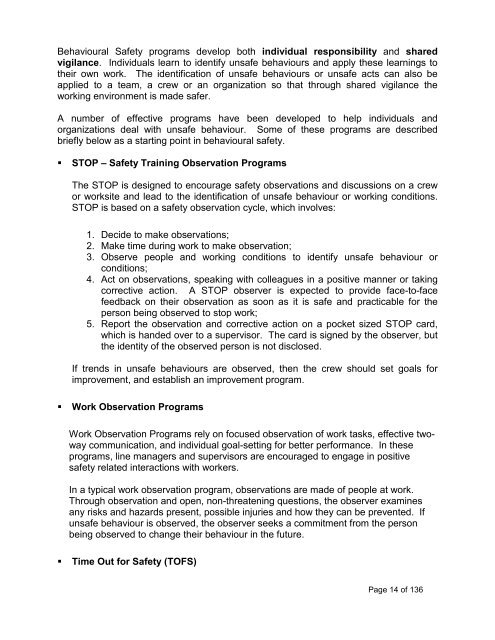IAGC LAND GEOPHYSICAL SAFETY MANUAL Edition 9 ... - CGISS
IAGC LAND GEOPHYSICAL SAFETY MANUAL Edition 9 ... - CGISS
IAGC LAND GEOPHYSICAL SAFETY MANUAL Edition 9 ... - CGISS
- No tags were found...
Create successful ePaper yourself
Turn your PDF publications into a flip-book with our unique Google optimized e-Paper software.
Behavioural Safety programs develop both individual responsibility and sharedvigilance. Individuals learn to identify unsafe behaviours and apply these learnings totheir own work. The identification of unsafe behaviours or unsafe acts can also beapplied to a team, a crew or an organization so that through shared vigilance theworking environment is made safer.A number of effective programs have been developed to help individuals andorganizations deal with unsafe behaviour. Some of these programs are describedbriefly below as a starting point in behavioural safety.! STOP – Safety Training Observation ProgramsThe STOP is designed to encourage safety observations and discussions on a crewor worksite and lead to the identification of unsafe behaviour or working conditions.STOP is based on a safety observation cycle, which involves:1. Decide to make observations;2. Make time during work to make observation;3. Observe people and working conditions to identify unsafe behaviour orconditions;4. Act on observations, speaking with colleagues in a positive manner or takingcorrective action. A STOP observer is expected to provide face-to-facefeedback on their observation as soon as it is safe and practicable for theperson being observed to stop work;5. Report the observation and corrective action on a pocket sized STOP card,which is handed over to a supervisor. The card is signed by the observer, butthe identity of the observed person is not disclosed.If trends in unsafe behaviours are observed, then the crew should set goals forimprovement, and establish an improvement program.! Work Observation ProgramsWork Observation Programs rely on focused observation of work tasks, effective twowaycommunication, and individual goal-setting for better performance. In theseprograms, line managers and supervisors are encouraged to engage in positivesafety related interactions with workers.In a typical work observation program, observations are made of people at work.Through observation and open, non-threatening questions, the observer examinesany risks and hazards present, possible injuries and how they can be prevented. Ifunsafe behaviour is observed, the observer seeks a commitment from the personbeing observed to change their behaviour in the future.! Time Out for Safety (TOFS)Page 14 of 136
















